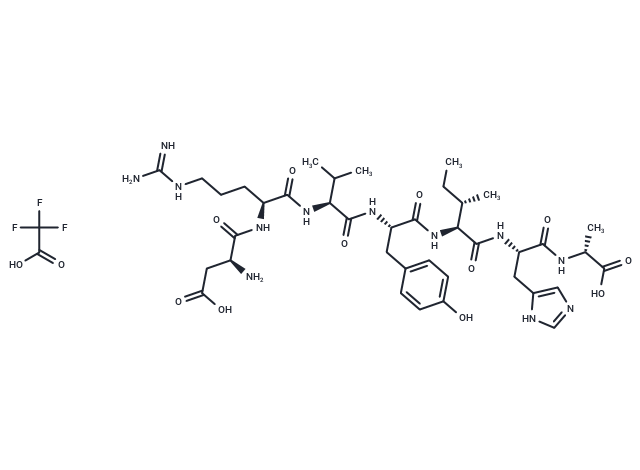Shopping Cart
Remove All Your shopping cart is currently empty
Your shopping cart is currently empty
A 779 TFA is a potent antagonist of angiotensin-(1-7) receptor.

| Pack Size | Price | USA Warehouse | Global Warehouse | Quantity |
|---|---|---|---|---|
| 1 mg | $50 | In Stock | In Stock | |
| 5 mg | $62 | In Stock | In Stock | |
| 10 mg | $92 | In Stock | In Stock | |
| 25 mg | $167 | In Stock | In Stock | |
| 50 mg | $250 | In Stock | In Stock | |
| 100 mg | $375 | In Stock | In Stock | |
| 1 mL x 10 mM (in DMSO) | $139 | In Stock | In Stock |
| Description | A 779 TFA is a potent antagonist of angiotensin-(1-7) receptor. |
| In vitro | A 779suppresses the proliferating cell nuclear antigen (PCNA) protein expression up-regulated by Ang II, but A 779alone has no effect to induce proliferation and migration of VSMCs.Pretreatment with Ang-(1-7) significantly retards Ang II-induced inflammatory responses of VSMCs associated with up-regulated MCP-1, VCAM-1 and IL-1β expressions, and this effect of Ang-(1-7) is blocked by A-779.But A 779alone has no effect to induce inflammatory response of VSMCs[1]. |
| In vivo | Inhibition of Ang1-7 cascade by A 779significantly eradicated captopril protective effects on bone metabolism, mineralization and micro-structure.A 779also restored OVX effects on RANKL expression and ACE-1/AngII/AT1R cascade and down-regulated OPG expression and ACE-2/Ang1-7/Mas pathway.In line with the clinical observations of the bone-preservative properties following ACE-1 inhibition, local activation of ACE-2/Ang1-7/Mas signaling and suppressed osteoclastogenesis seem responsible for the osteo-preservative effect of captopril, which could offers a potential therapeutic value in treatment of disabling bone and skeletal muscular diseases[2]. |
| Cell Research | HUVECs were cultured in vitro and divided into six groups:?the control group (normal medium), the ox-LDL group(treated with 75 mg/L ox-LDL), the ox-LDL+ Ang-(1-7) group (1 μmol/L Ang-(1-7) pretreated for 30 minutes, then intervened with 75 mg/L ox-LDL), the ox-LDL+ Ang-(1-7)+ A-779 group(1 μmol/L A-779 (Mas receptor) pretreated for 30 minutes, 1 μmol/L Ang-(1-7) pretreated for 30 minutes, then intervened with 75 mg/L ox-LDL), the ox-LDL+ A-779 group (1 μmol/L A-779 pretreated for 30 minutes, then intervened with 75 mg/L ox-LDL),?the ox-LDL+ HTA125 group (10 μg/L HTA125 (TLR4-blocking antibody) pretreated for 30 minutes, then intervened with 75 mg/L ox-LDL ).?The corresponding index was detected after 24 hours after intervention.?Apoptosis of cells were detected by Annexin V-FITC/PI double staining flow cytometry and transferase-mediated deoxyuridine triphosphate-biotin nick end labeling (TUNEL).?The generation of reactive oxygen species (ROS), products in oxidative stress, were detected by DCFH-DA staining.?The mRNA and protein expression levels of NADPH oxidase 4(NOX4) and TLR4 were detected by real-time reverse transcription-polymerase chain reaction (RT-PCR) and Western blotting analysis respectively[1]. |
| Synonyms | A 779 3TFA(159432-28-7(free base)) |
| Molecular Weight | 987.01 |
| Formula | C41H61F3N12O13 |
| Smiles | OC(=O)C(F)(F)F.CC[C@H](C)[C@H](NC(=O)[C@H](Cc1ccc(O)cc1)NC(=O)[C@@H](NC(=O)[C@H](CCCNC(N)=N)NC(=O)[C@@H](N)CC(O)=O)C(C)C)C(=O)N[C@@H](Cc1cnc[nH]1)C(=O)N[C@H](C)C(O)=O |
| Relative Density. | no data available |
| Storage | Powder: -20°C for 3 years | In solvent: -80°C for 1 year | Shipping with blue ice/Shipping at ambient temperature. | ||||||||||||||||||||
| Solubility Information | DMSO: 11.78 mg/mL (11.94 mM), Sonication is recommended. | ||||||||||||||||||||
Solution Preparation Table | |||||||||||||||||||||
DMSO
| |||||||||||||||||||||
| Size | Quantity | Unit Price | Amount | Operation |
|---|

Copyright © 2015-2025 TargetMol Chemicals Inc. All Rights Reserved.